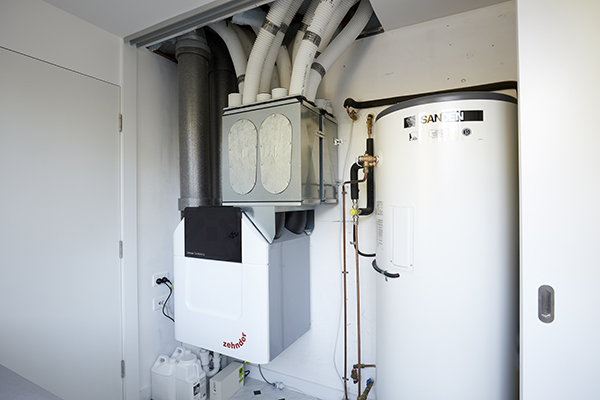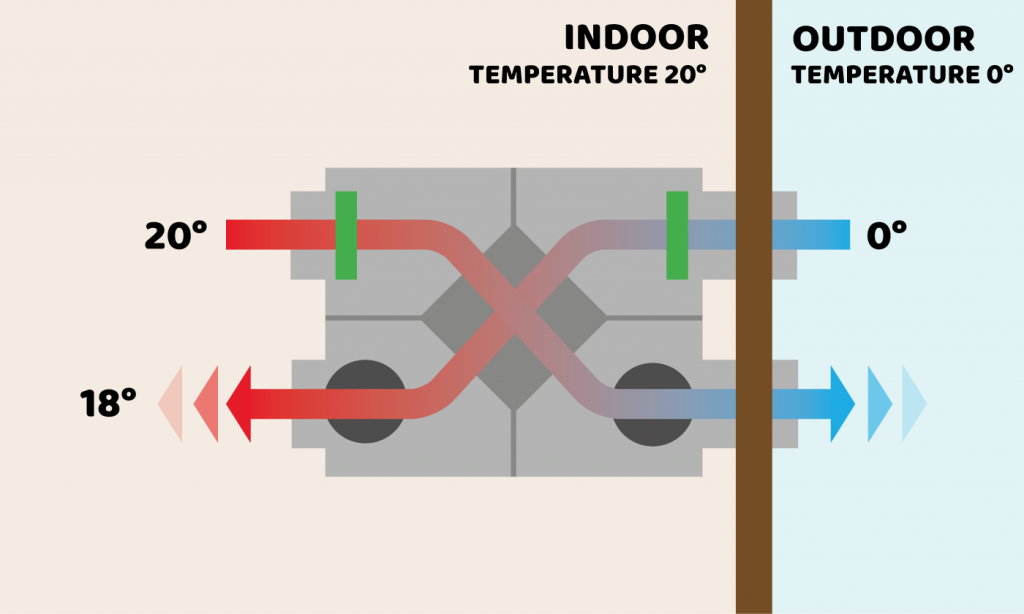Introducing the Trick Advantages and Uses of Heat Recovery Ventilation in Lasting Design
Heat Recovery Ventilation (HRV) systems play an important role in lasting style. They assist in a continuous exchange of stagnant indoor air with fresh exterior air, significantly improving indoor air top quality. HRVs add to energy efficiency by reclaiming warm from worn down air, which can lower energy prices. Recognizing the diverse benefits and applications of HRVs reveals their relevance in contemporary architecture. What various other benefits do these systems use in the pursuit of sustainability?
Understanding Heat Recovery Ventilation Systems
Heat recovery ventilation (HRV) systems are made to boost interior air quality while minimizing energy loss. These systems use a mechanical ventilation method to exchange stagnant interior air with fresh outdoor air, making certain a continuous supply of tidy air. By capturing warm from the exhaust air, HRVs prerequisite inbound air, decreasing the need on heating and cooling down systems. This process not only enhances thermal convenience yet likewise adds to energy performance in residential and industrial structures. Additionally, HRV systems assist regulate humidity levels and minimize interior toxins, promoting a healthier living atmosphere. Their calculated execution is vital for attaining sustainable style objectives, as they supply a balance between energy conservation and occupant wellness.
Just How HRV Equipment Job
While lots of may recognize with ventilation systems, recognizing how heat recovery ventilation (HRV) systems run is vital for appreciating their benefits. HRV systems function by trading stagnant interior air with fresh outdoor air while moving warm between both streams. This procedure takes place in a warmth exchanger, where warmth from the outward bound air warms up the inbound air during chillier months, reducing energy loss. Alternatively, in warmer months, the system can cool down inbound air making use of the cooler outgoing air. HRVs are geared up with followers to facilitate airflow and filters to eliminate particulates, making sure a continual, balanced air flow procedure. This innovative layout not just boosts energy effectiveness but likewise adds to preserving a comfy indoor atmosphere.
Enhancing Indoor Air Quality
Interior air top quality can greatly impact health and wellness and wellness, making reliable ventilation essential in modern homes. Heat Recovery Ventilation (HRV) systems play a necessary duty in maintaining indoor air high quality by continually trading stale indoor air with fresh exterior air. This process not just reduces airborne toxins but likewise minimizes moisture degrees, which can lead to mold and mildew development and breathing concerns. HRV systems filter incoming air, eliminating irritants and particulates, thereby offering a much healthier living environment. Furthermore, these systems help get rid of smells and volatile natural compounds (VOCs) generally located in family items. By making sure a consistent circulation of tidy air, HRV systems add to a total enhanced interior ambience, promoting comfort and well-being for passengers.
Power Performance and Price Savings
Energy effectiveness attracts attention as a significant advantage of Heat Recovery Ventilation (HRV) systems. By catching and reusing the warm from worn down indoor air, HRVs reduce the energy required for home heating inbound fresh air, leading to reduced energy consumption. This effectiveness equates right into lower utility bills, offering substantial cost financial savings for homeowners and organizations alike. Furthermore, HRV systems typically get power effectiveness rewards and refunds, even more improving their financial appeal. Over time, the initial financial investment in HRV modern technology can bring about a desirable roi via lowered energy costs. The combination of HRV systems not just advertises sustainable style yet likewise gives a sensible remedy for accomplishing long-term energy savings and economic advantages.
Ecological Benefits of HRV

A wide range of environmental advantages develops from the execution of Heat Recovery Ventilation (HRV) systems. By effectively moving warm from exhaust air to inbound fresh air, HRVs substantially minimize the power required for home heating and cooling down spaces. This power efficiency translates to lower greenhouse gas exhausts, contributing to a reduction in the overall carbon impact of buildings. Additionally, HRV systems boost indoor air high quality by continuously distributing fresh air, therefore reducing the concentration of interior pollutants and irritants. The reduction in power usage help in conserving all-natural resources, making HRVs a crucial element of lasting design. On the whole, the environmental advantages of HRVs play a vital function in promoting a much healthier earth and promoting environment-friendly building techniques.
Versatile Applications in Modern Architecture
Heat recovery ventilation (HRV) systems are significantly being incorporated into both domestic and industrial building projects. In property setups, HRVs improve indoor air high quality while taking full advantage of power efficiency. At the same time, in commercial areas, these systems maximize air flow approaches, demonstrating their convenience in modern building applications.
Residential Projects Integration
While contemporary design significantly highlights sustainability, the combination of warm healing air flow systems in household tasks has actually become a useful option for improving indoor air high quality and power effectiveness. These systems successfully move warm from exhaust air to inbound fresh air, decreasing power loss and reducing heating or cooling demands. In new builds and retrofits alike, warmth recovery ventilation can be perfectly integrated, offering homeowners with a healthier living atmosphere while decreasing energy prices. Furthermore, with boosting awareness of environmental effects, even more engineers and builders are recognizing the long-term advantages of these systems. As a result, warm healing air flow has actually become an important component of sustainable residential design, showcasing adaptability and commitment to eco-friendly practices.
Business Spaces Optimization
As modern-day industrial areas progress to satisfy the demands of sustainability and performance, the implementation of warm recovery air flow systems emerges as a key strategy for optimizing indoor environments. These systems facilitate the exchange of stale interior air with fresh outside air while reclaiming heat, considerably reducing power usage. This not just improves convenience for passengers but additionally helps in reducing functional costs. Functional applications can be observed in offices, retail areas, and universities, where air top quality and temperature control are critical. In addition, incorporating warmth healing air flow lines up with environment-friendly building qualifications, even more promoting environmental duty. Eventually, taking on such systems in business design not only adds to sustainability goals yet also promotes much healthier, much more productive rooms for individuals.
Incorporating HRV Into Sustainable Layout Practices
Integrating warm recuperation air flow (HRV) systems into lasting design practices offers substantial advantages in power efficiency and indoor air high quality. By using HRV, designers can produce economical options that not just lower power intake however also enhance the total convenience of indoor environments. This alignment with sustainability objectives settings HRV as a necessary element in modern architectural approaches.
Energy Performance Enhancement
By integrating heat recuperation air flow (HRV) systems right into sustainable layout methods, architects and home builders can significantly enhance power performance in contemporary buildings. HRV systems function by catching heat from outbound stagnant air and transferring it to inbound fresh air, lessening the power needed for home heating or cooling interior areas. This procedure not only reduces dependence on typical heating and cooling systems but likewise lowers general power consumption. Additionally, HRV systems can help keep a consistent interior temperature, minimizing peak HRV Heat Recovery Ventilation power demands. By incorporating these systems, buildings can accomplish substantial reductions in energy costs and carbon impacts, lining up with sustainability objectives. Inevitably, HRV modern technology represents a useful option for boosting energy effectiveness in the developed setting, promoting more liable source use.
Indoor Air Quality Improvement
Just how can heat recuperation ventilation (HRV) systems add to premium indoor air top quality in contemporary buildings? HRV systems effectively exchange stagnant indoor air with fresh outside air while recovering warm energy, decreasing temperature changes. This process minimizes the focus of indoor pollutants, such as unstable organic substances (VOCs), irritants, and dampness, which can wear away air high quality and effect passenger wellness. By keeping perfect moisture degrees and ensuring a continuous supply of clean air, HRVs assist produce a much healthier indoor environment. Additionally, these systems can be integrated into sustainable design practices, promoting power performance along with boosted air top quality. HRV Heat Recovery Ventilation. Consequently, HRV technology plays an important role ahead of time overall passenger comfort and wellness in modern building designs
Affordable Design Solutions

Frequently Asked Inquiries
What Upkeep Is Required for Heat Recovery Ventilation Equipments?

Upkeep for warm healing ventilation systems generally includes regular filter replacements, cleansing of warmth exchangers, assessment of followers and ducts, and making certain proper drain. These jobs assist preserve performance and extend the system's life expectancy in time.
Can HRV Systems Be Mounted in Existing Structures?
Heat recovery ventilation systems can without a doubt be set up in existing structures. HRV Heat Recovery Ventilation. Retrofitting requires cautious preparation and evaluation of the structure's layout, making certain compatibility with existing systems while making the most of power effectiveness and indoor air quality
How Do HRV Solution Effect Noise Levels Indoors?
HRV systems can influence interior noise levels by introducing sound from external sources through ventilation. Top quality setups usually include sound-dampening features, minimizing noise impact while offering efficient air exchange and maintaining comfort inside your home.
Are There Any Kind Of Disadvantages to Making Use Of HRV Systems?
The downsides of using HRV systems consist of possible high first costs, maintenance obstacles, and the possibility of decreased indoor air quality if filters are not frequently changed, which can cause problems with humidity degrees.
Exactly how Do I Choose the Right HRV System for My Needs?
Picking the right heat recovery air flow system entails examining certain requirements, such as building size, environment, and power effectiveness goals. In addition, examining system functions, installation needs, and upkeep considerations is important for peak efficiency and complete satisfaction.